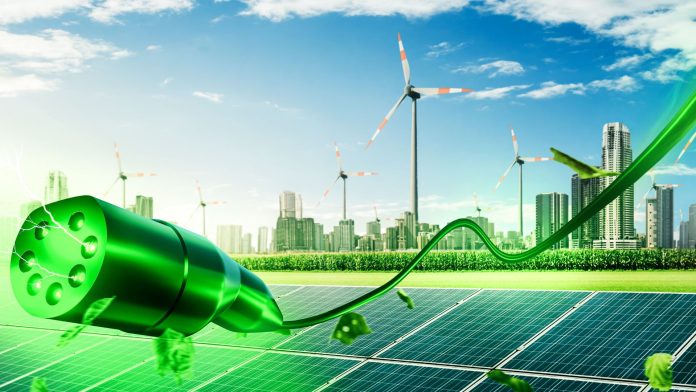RESC Report on Electric Power Movements in January 2024
The electricity production in January had participation of 77.2% from all renewable sources and 22.8% from non-renewable sources, while in the available electric energy, renewable sources participated with 65.6%.
Hydropower plants played a dominant role in electricity production (42.9%). Other RES took second place (22.7%) ahead of non-renewables (19.4%) and ahead of the Croatian share of the Krško NPP (15%).
Wind farms achieved a historically record production of 294 GWh, thus exceeding the production of electricity from the Croatian part of the Krško NPP (50%) by 34 GWh.
Aware of the interest in understanding the evolution of electricity consumption and production, particularly renewable energy, in Croatia and Europe, and emphasizing the importance of these technologies in measures against climate change while reinforcing our commitment to be current with statistical data in the electric power sector, we present a monthly report on the electrical energy opportunities in the Croatian electric power system.
Renewable Energy Production
According to preliminary data, renewable energy sources could close the year 2023 with a contribution to the annual national electricity production of almost 70%.
This would mark the highest RES production to date of 11,757 GWh, which is 34.7% more than the value achieved in 2022.
The production of wind and solar power plants in 2023 was at historically record levels of production across all time levels, with a share in available energy of 14.5%, surpassing the Croatian 50% share in the Krško NPP production by 0.9%.
Electric Power Movements in Croatia in January 2024
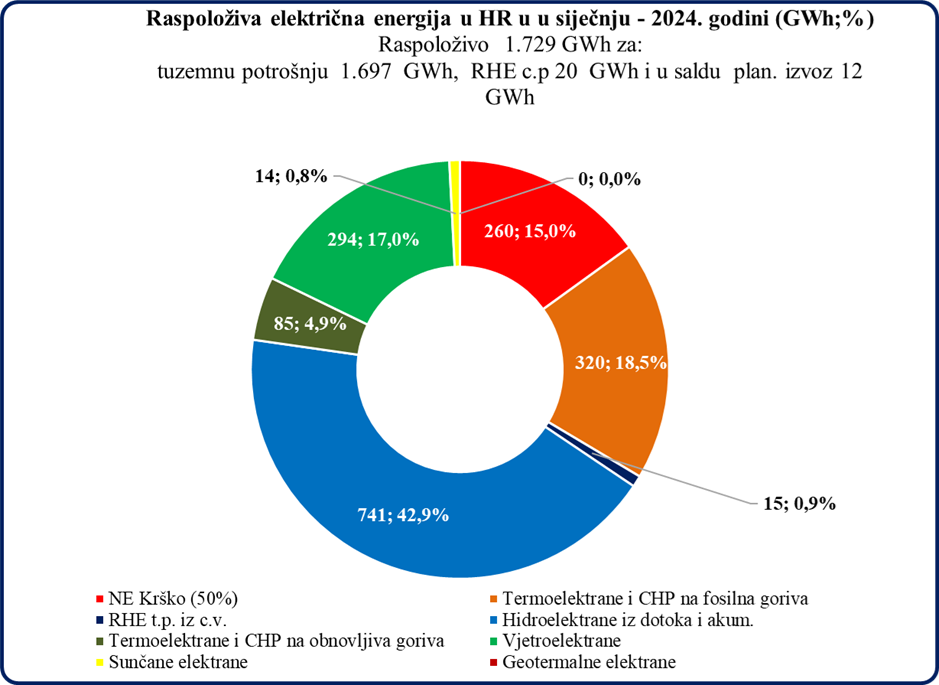
January 2024 was a month with significant temperature changes, and a large increase in electricity consumption was recorded, as expected, on cold days. The daily consumption variability is visible, depending on whether it is a working day or a holiday and depending on the air temperature and heating needs.
Due to the higher air temperature by 0.4 °C compared to the norm, the electricity consumption for heating was 10 GWh less than the normal consumption in January.
The month was marked by very high production from hydropower plants due to water inflow with little accumulation filling. The Plomin Thermal Power Plant was out of operation for the entire month, and the Velebit Pumped-Storage Hydro Power Plant had significant operation in pump-turbine mode (pump mode consumption was 20 GWh).
To balance the hourly balance, it was necessary to perform occasional exchange at interconnections, so the import of electricity amounted to 85 GWh, and the export was 97 GWh, resulting in a net export difference of 12 GWh.
The Krško NPP operated at full power, and all safety systems were operational, with the Sava River being heated far below the permitted 3 ºC.
Renewable energy sources produced more electricity than thermal power plants (58 GWh more) and from the Croatian part of the Krško NPP (133 GWh more), thus taking second place in the energy mix for January 2024.
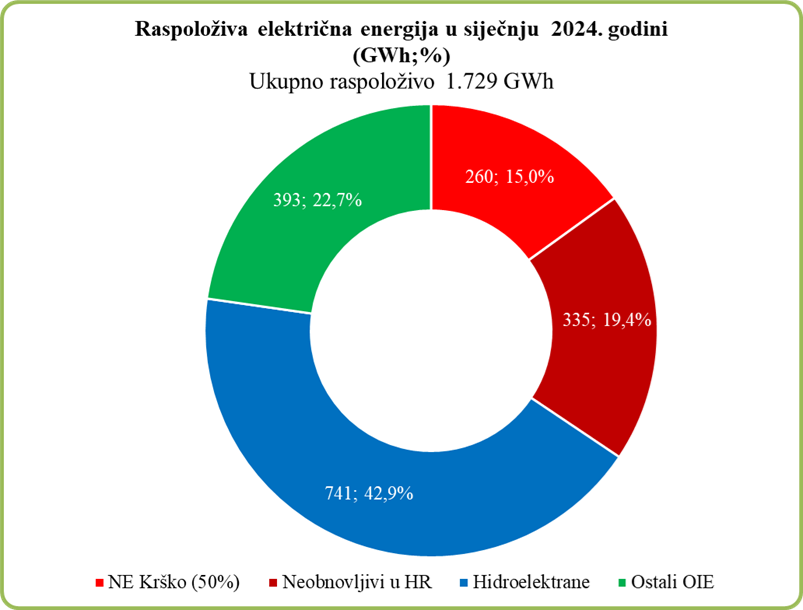
Hydropower plants had a dominant role in electricity production (741 GWh, 42.9%) with accumulation filling of 27 GWh. Other RES took second place (393 GWh, 22.7%), ahead of non-renewables (335 GWh, 19.4%) and ahead of the Croatian 50% of the Krško NPP (260 GWh, 15%). A graphical representation is shown in the upper picture.
The maximum daily coverage of total energy consumption from renewable sources in January 2024 was 97% (January 7th), with hydropower plants participating at 53%, and other RES at 44%.
The minimum daily coverage of total energy consumption from renewable sources in January 2024 was 42% (January 31st), with hydropower plants participating at 34.8%, and other RES at 7.2%.
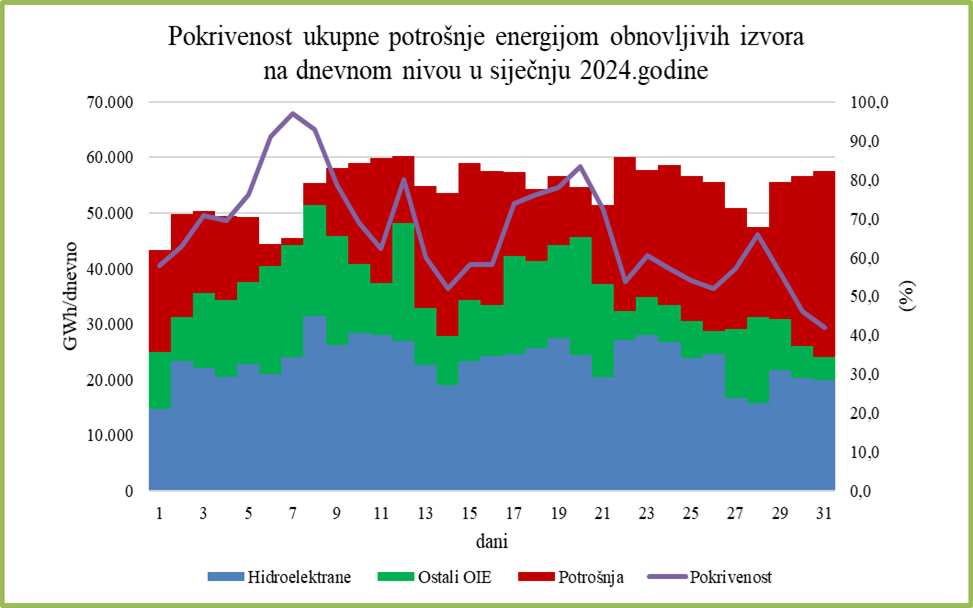
Wind and Solar Power Plant Production in January 2024
Wind Farms
The installed capacity of all wind farms as of January 1, 2024, remained the same as reported in December 2023, totaling 1,160.15 MW, with the approved grid connection capacity being 1,136.85 MW.
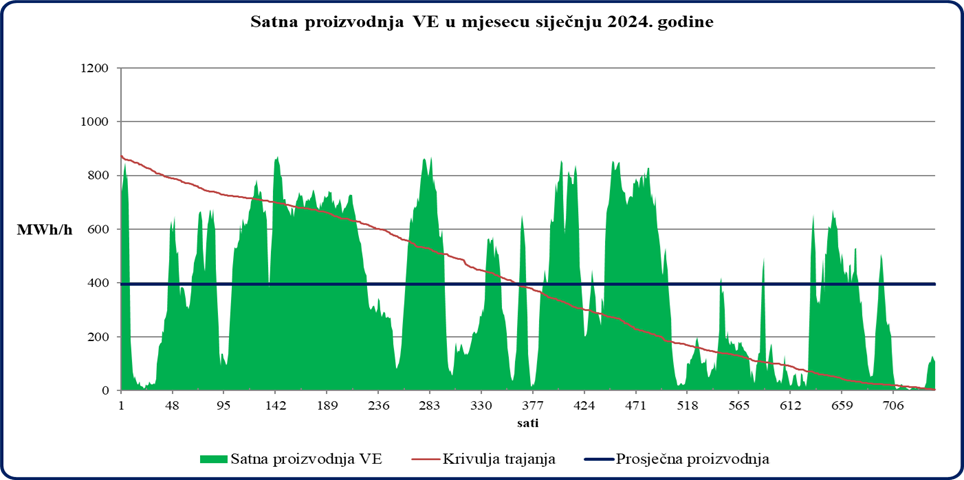
The total production of wind farms in January 2024 was 294 GWh, representing a historically record production, with the note that wind farms produced more electricity than the Croatian part of the Krško NPP (50%) by 34 GWh. The capacity utilization factor was 34.8% (the average for January in the period from 2011 to 2023 was 32.3%).
The average hourly production of wind farms in January was 395.1 MWh/h, the maximum hourly production was 872 MWh/h, and the maximum capacity utilization factor was 76.7% on an hourly level.
Solar Power Plants
As of January 1, 2024, there were 462.5 MW of solar power plants in operation (an average monthly addition of 19.9 MW throughout 2023), which is equal to the data presented in the report for December 2023. Assuming this trend continues, the annual production from solar power plants in 2024 could be expected to reach 810 GWh, representing about 4.4% of domestic consumption.
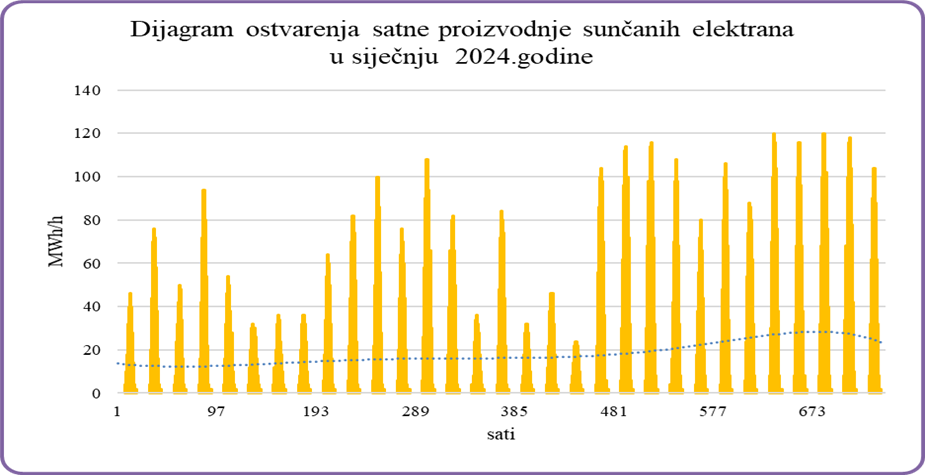
The realized capacity utilization factor for solar power plants in January 2024 was 4.1%. An increased daily production was visible due to the lengthening of days (insolation) during January.
Other Characteristics of Electric Power Movements for January 2024
The maximum daily turnover was 86,197 MWh, and the maximum daily consumption was 60,186 GWh. The transmission network withstood everything well.
| January | Monthly | Monthly | |
| GWh | GWh | ||
| System input | 2.129 | System output | – 2.129 |
| Production at the threshold non-RES in Croatia | 335 | Konzum | – 1.697 |
| Production at the threshold RES in Croatia | 1.134 | RHE c.p | -20 |
| NE Krško (50%) | 260 | ||
| Planned import | 85 | Planned export | – 97 |
| Non-planned import (transit) | 315 | Non-planned export (transit) | -315 |
The average hourly market price (Cropex) was €83.02/MWh in January 2024. A very good realization of market values for almost all technologies in the electric power balance was achieved, with the engagement of production operators, trade operators, and system operators who market and exchange the production of all technologies at the most favorable market prices. The overall economic effect of good operator performance relative to market prices amounted to about +€3.6 million for all technologies.
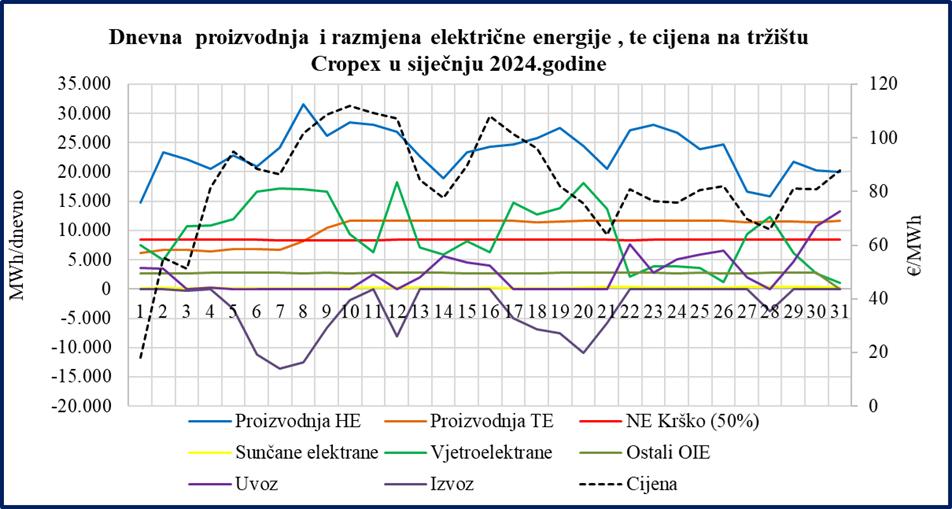
This report was prepared using publicly available data published on the websites of HEP, HOPS, ODS, HROTE, CROPEX, Krško NPP, ENTSO, DZS, RTE France, RED Electrica, World Data, IEA, EEX, EPEX, IRENA.
The analyses published in the monthly OIEH Reports are made available to all those who wish to be informed about the operation and development of the Croatian electric power system. The quality and continuity of the service we provide in these analyses stem from a sustainable vision focused on a culture of informing about the operation and development of renewable energy sources in our country.


